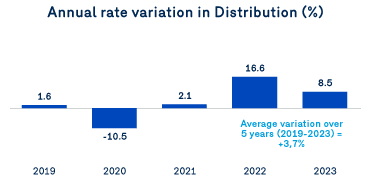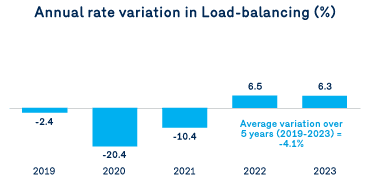Express Blue Bulletin
New rates for fall 2022
The rates proposed by Énergir were filed with the Régie de l’énergie on May 13 and are pending approval, with an intended application date on October 1, 2022.
Summary of changes
The 2022 2023 Rate Case proposes an overall rate increase of 7.8%, broken down as follows:
- 8.5% increase in distribution rates
- 6.4% increase in transportation rates
- 6.3% increase in load-balancing rates, and
- 13.5% increase in cap-and-trade system inventory adjustments.
The rate adjustments to the distribution, transportation and load-balancing services are explained below.
Distribution service
For 2022-2023, the increase in distribution rates can mainly be explained by:
- The increase in the depreciation expenses in the deferred expense account (DEA), chiefly due to the amounts to be recovered in the 2022-2023 rates because of the higher temperatures in 2021, the increased depreciation of IT development projects, and the increase in the balances to be recovered from customers related to revenue decoupling.
Transportation service
The increase in the rate for the transportation service is caused mostly by:
- The shortfall noted during the 2020-2021 year-end closing, whose recovery is included in the 2022-2023 Rates Case. This shortfall comes from the exceptional 3-year extension of deferred expenses to attenuate in part the impact this shortfall would have had on the increase in the transportation rate in the 2021-2022 Rates Case.
- The application of a new functionalization method that calls for recovering the return on the rate base and a tax on revenue in transportation through the transportation rate.1
1 D-2021-109 rendered in File R-3867-2013
Load-balancing service
The rate increase for the load-balancing service comes principally from:
- An increase in load-balancing costs, essentially due to the elimination of a DEA related to the combination of fixed premiums for the storage site, which caused a one-time depreciation expense, and the acquisition of a winter transportation tool functionalized in the load-balancing.
- The application of a new functionalization method for costs, which transfers the entire value of supply inventories to load-balancing.
Details of variations
The table shows the average variation on a bill attributable to the three services indicated below for each Distribution rate.
To understand the variances in transportation (T), load-balancing (L-B) and distribution (D) services, and the adjustments related to inventories (I) for each rate tier, click here.

Annual rate variations per service
Following the considerable rate increases in 2021-2022, the proposed rate increases are lower in 2022-2023.



What are deferred expenses?
A DEA is a regulatory tool used to calculate fees incurred that will be deferred to a later date. Depending on the situation, deferred fees may be remitted to or recovered from customers. If there are fees to be recovered, there will be a rate increase. If there are fees to be remitted, there will be a rate decrease. There are a number of reasons for using DEAs. The most common is the determination of actual results at the end of the year that prove to be higher or lower than anticipated in the rate case. The resulting difference is then incorporated into a subsequent year’s rates.